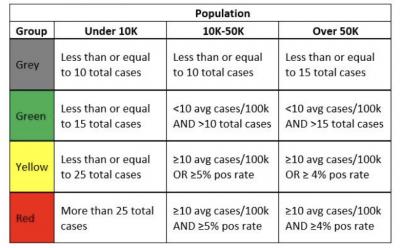Here’s how the covid color coding system works
You’ve probably heard terms like “in the red” or “yellow community” to describe a town’s current level of covid cases. But what exactly do those colors mean?
Well, each community in the state is labeled with a color depending on how many active covid cases are in the community. From the fewest cases to the most, the color coding goes from gray, to green, to yellow, to red.
But the exact number of cases required for a town to reach a specific color designation differs based on that community’s population.
Communities are separated into three categories based on population: under 10,000, between 10,000 and 50,000, and over 50,000.
In larger communities, designations are determined by case count as well as cases per 100,000 residents and positive case rates. Positive case rates are the percentage of tests that come back positive for covid.
Marion, Mattapoisett and Rochester each fall into the under 10,000 residents category.
In the under 10,000 category, color designation is determined by sheer case count.
Less than or equal to 10 cases designates the community as gray, between 10 an 15 cases puts a community in green, less than or equal to 25 cases marks a town as yellow, and communities with more than 25 cases are designated as red.
For instance, Rochester shifted from a gray designation, with 10 cases, to yellow, with 16 cases ahead of Thanksgiving.
Previously, these thresholds were lower, but were raised by the state in early November.
A major change from the old system is that the green designation is now relevant for smaller communities like the Tri-Town, since smaller communities now use sheer case counts instead of counts scaled with population.
For a chart showing all thresholds for color designations, see the online version of this article at sippicanweektoday.com.














